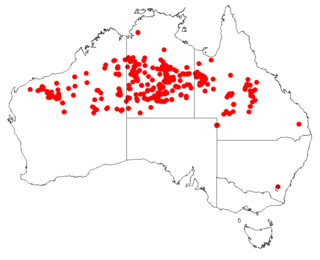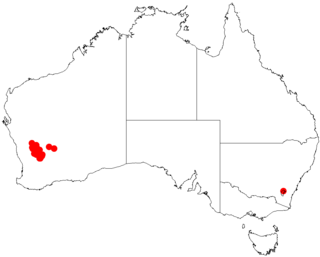
Acacia adsurgens is a shrub belonging to the genus Acacia and the subgenus Juliflorae. It is native to the northern areas of Australia.

Acacia ancistrocarpa, commonly known as fitzroy wattle, is a shrub belonging to the genus Acacia and the subgenus Juliflorae. The shrub is also known as fish hook wattle, pindan wattle and shiny leaved wattle.

Acacia desertorum is a shrub belonging to the genus Acacia and the subgenus Juliflorae that is endemic to western Australia.

Acacia gardneri is a shrub belonging to the genus Acacia and the subgenus Juliflorae native to Western Australia.

Acacia jibberdingensis, also known as Jibberding wattle or willow-leafed wattle, is a shrub or tree belonging to the genus Acacia and the subgenus Juliflorae that is endemic to Western Australia.
Acacia lentiginea is a shrub belonging to the genus Acacia and the subgenus Juliflorae that is endemic to north western Australia.

Acacia sessilispica is a shrub belonging to the genus Acacia and the subgenus Juliflorae native to Western Australia.

Acacia websteri is a shrub or tree belonging to the genus Acacia and the subgenus Juliflorae that is endemic to western Australia.

Acacia calcarata is a shrub belonging to the genus Acacia and the subgenus Phyllodineae.

Acacia excentrica is a shrub belonging to the genus Acacia and the subgenus Phyllodineae native to Western Australia.

Acacia merrickiae is a shrub belonging to the genus Acacia and the subgenus Phyllodineae that is endemic to a small area of south western Australia.

Acacia pachyacra is a tree or shrub belonging to the genus Acacia and the subgenus Phyllodineae. that is endemic to arid parts of central and western Australia.

Acacia sedifolia is a shrub of the genus Acacia and the subgenus Phyllodineae that is endemic to south western Australia.

Acacia semicircinalis commonly known as Wongan wattle or Wongan sprawling wattle, is a shrub of the genus Acacia and the subgenus Phyllodineae that is endemic to a small area in western Australia. The species was once listed as a threatened species according to the Environment Protection and Biodiversity Conservation Act 1999 but was removed in 2006.

Acacia abrupta is a shrub of the genus Acacia and the subgenus Plurinerves that is endemic to arid parts of central and western Australia.
Acacia acellerata is a shrub of the genus Acacia and the subgenus Plurinerves. It is native to an area in the Great Southern region of Western Australia.

Acacia chrysopoda is a shrub of the genus Acacia and the subgenus Plurinerves that is endemic to an area of south western Australia.

Acacia fragilis is a shrub of the genus Acacia and the subgenus Plurinerves that is endemic to south western Australia.

Acacia obtecta is a shrub of the genus Acacia and the subgenus Plurinerves that is endemic to a small area in south western Australia.

Acacia gracilifolia, commonly known as graceful wattle, is a shrub belonging to the genus Acacia and the subgenus Plurinerves native to a small area of central southern Australia.


















